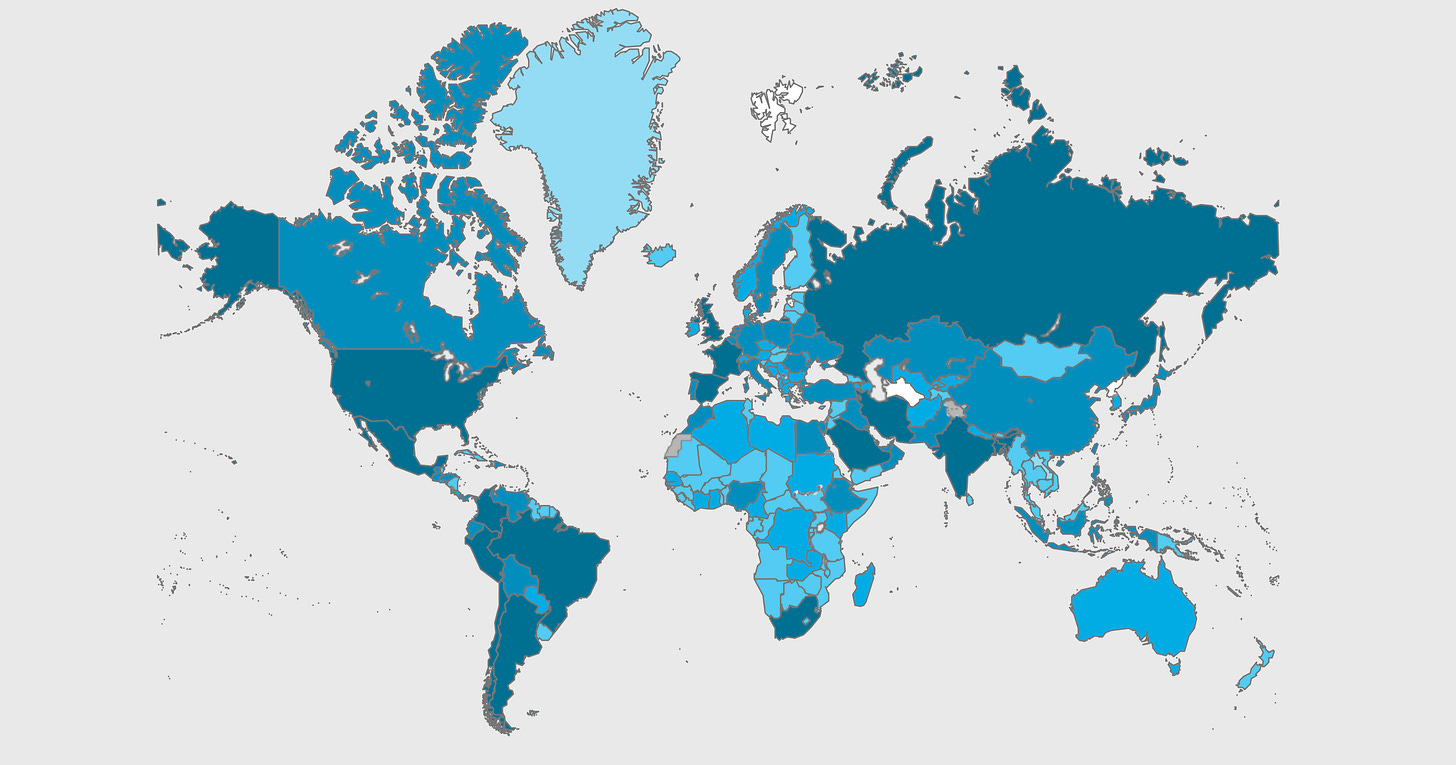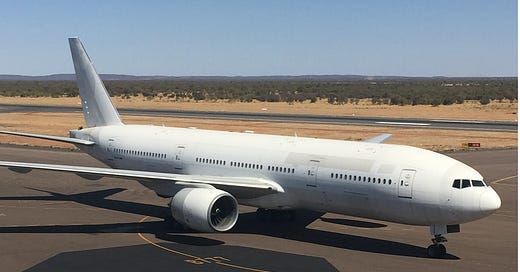Asia Travel Re:Set #2 - Could Entire Travel Economies Turn to Dust?
Vaccine Bubbles, Boneyards, Beijing Flights & Two Indian Icons
Hey, Welcome back to Asia Travel Re:Set.
From this weekend onwards, the newsletter will ease into its regular rhythm – direct to your inbox each Sunday and Wednesday.
Apologies for veering slightly off-piste in this initial “pilot” week. I assure you it’s just temporary turbulence.
[Who knew all the admin issues involved with setting up a newsletter service – even for someone who worked in publishing for many years!]
I aim to keep the midweek edition a little lighter, with most of the detailed analysis reserved for Sunday. That said, there’s a piece below about vaccines and travel bubbles.
That’s pretty heavy.
Upcoming, I’ve lined up some new features, formats and interviews for the midweek editions. I look forward to unveiling those.
So, let’s get started with Issue 2…
Thanks for jumping onboard.
The Midweek Itinerary:
- Asian Aviation by Numbers
- “This virus is just beating us all, isn’t it?”
- ‘Vaccine or Bust’ for Travel Reopening in SEA?
- Are Airline Restaurants Now a Thing?
- Re-Upping the Power of Words in Travel
- Two Brighter Spots

Asian Aviation by Numbers
293: The number of daily domestic flights Japan Airlines will operate from 1-10 October, down from 304 daily [17-30 Sept]. This represents 34% (ie, one-third) of ‘normal’ capacity, down from 42% [26 Aug-16 Sept]. In Japan. For Chinese Golden Week. In ‘Olympic’ year. Surreal.
90: Cathay Pacific may reportedly park this many planes at the Asia Pacific Air Storage facility (also known as a ‘boneyard’) near Alice Springs, Australia.
7: Virgin Australia will discontinue this number of route services, including flights connecting Sydney with Ayers Rock and Hervey Bay. It’s also stopping international flights to/from Tonga.
4: The number of Asian airlines (China Southern #1, China Eastern #4, Air China #7 and All Nippon Airways #9) ranked in the world’s top 10 last week for seat capacity.
-8.9%: China’s domestic air sector edged a little closer last week to parity with its January 2020 capacity level (and Golden Week is coming!). Russia leads the globe, however – down just 3.7% on January 2020.

“This virus is just beating us all, isn’t it?”
With 2020 fast slipping into the sunset, attentions are turning to 2021 – and initiatives to prevent the travel industry (and entire economies) disappearing into the dust. There’s been a noticeable direction change in the past month – with hopes pivoting toward the approval, manufacture and (free?) distribution of a COVID-19 vaccine.
On 9 September, the World Health Organisation (WHO) published a list of 35 candidate vaccines, which are undergoing clinical trials worldwide, plus 145 more vaccines that are advancing through the “preclinical evaluation” stage. So, 180 vaccines in total are in the works.
This week, Indonesia allocated USD28 billion for a multi-year project to develop a homegrown COVID-19 vaccine. The government previously announced it is partnering with China’s Sinovac and the UAE’s Kimia Farma and Group 42 Healthcare to purchase, in phases, up to 340 million vaccine doses by the end of 2021. Indonesia also plans to produce these vaccines at newly constructed facilities under license.
“Vietnam says it is preparing to trial four versions of a vaccine, including one being jointly researched with scientists from Cuba.”
China counts four vaccines that are currently undergoing patient trials, two by Sinopharm (in Wuhan and Beijing), one by Sinovac and one by CanSino. Meanwhile, Vietnam says it is preparing to trial four versions of a vaccine, including one being jointly researched with scientists from Cuba. Russia has already staked its claim to granting regulatory approval for a coronavirus vaccine.
Also this week, Australia’s Department of Health announced an AUD1.7 billion programme to purchase and produce COVID-19 vaccines from two sources, the University of Oxford-Astra Zeneca and the University of Queensland/CSL. The former deal would provide “early access to 3.8 million doses of the Oxford vaccine in January and February 2021”.
“Australia pre-contracted doses of the University of Oxford-Astra Zeneca vaccine – known as AZD1222 – which abruptly halted clinical trials on 9 September.”
Eagle-eyed readers will spot that Australia pre-contracted doses of the University of Oxford-Astra Zeneca vaccine – known as AZD1222 – which abruptly halted clinical trials on 9 September. An official release announced a “pause of vaccination across all trials” following a “single unexplained illness that occurred in the UK Phase III trial.”
An independent investigation is now under way, but it is unclear how long this will take. Astra Zeneca says it is “working to expedite the review of the single event to minimise any potential impact on the trial timeline.”
Takeaways:
- 180 COVID-19 vaccines are being researched worldwide
- The University of Oxford-Astra Zeneca trials are currently paused
- Vietnam is working with Cuban experts on one of its four vaccine blueprints.
Quote:
“172 economies are engaged in discussions to potentially participate in COVAX, a global initiative aimed at working with vaccine manufacturers to provide countries worldwide equitable access to safe and effective vaccines, once they are licensed and approved,” WHO, 24 August.

‘Vaccine or Bust’ for Travel Reopening in South East Asia?
On The South East Asia Travel Show this week, we fend off feelings of despair, and tackle various approaches for restarting travel. From Iceland to Bali, Phuket to Maldives, China to New Zealand, we assess the measures that were tried, those being ruled out, and some that offer faint hopes for the near future. En route, we wonder whether “Vaccine Bubbles are moving onto the radar” – and canvas ideas from travel industry figures about how to revive tourism, before it is just too late.
“Vaccine Bubbles are moving onto the radar.”
Are Airline Restaurants Now a Thing?
Love it or hate it, in-flight food became (pre-COVID-19) a trusted revenue source for LCCs that focus strategically on ancillary revenues. Now, in these truly surreal times, airline meals are being served on the ground – not just in the air
As a vegetarian, I rarely eat in-flight – mostly because I forget the “pre-order” requirement. Some airlines (the ones that route through the Middle East and India in my experience) hold spare non-meat meals onboard. Many others tend to be quite dismissive of guests who fail to pre-reserve.
But back to the main thread…
This week, Thai Airways opened an airplane-themed restaurant at its Bangkok head office. Diners can tuck into meals prepared by chefs from its catering team. Open from Wednesday to Friday, the restaurant replicates the airplane boarding experience. Guest enter via a set of aircraft stairs, and dine while sat on repurposed cabin seats. The dining tables are upcycled from discarded aircraft engines and tyres.
Last December, Malaysia-based LCC group AirAsia launched its flagship Santan restaurant in Kuala Lumpur’s Mid-Valley shopping mall. Santan serves dishes (such as Pak Nasser’s Nasi Lemak and Uncle Chin’s Chicken Rice) inspired by the culinary cultures of its South East Asian route network. These meals have proved incredibly popular in recent years on the in-flight menu, also called Santan (meaning ‘coconut milk’). At the time of opening in Mid-Valley, AirAsia set an optimistic target to roll out 100 franchised outlets within 5 years, including “expansions in global markets.”
Such optimism seems to hail from a distant era now, doesn’t it?
“At the time of opening the first Santan in Kuala Lumpur, AirAsia set an optimistic target to roll out 100 franchised outlets within 5 years.”

Re-Upping the Power of Words in Travel
For eight long months, the global travel sector has been suffocated by the pandemic. The impact in Asia Pacific has been particularly notable given the pace and scale of industry growth throughout the 2010s. These, of course, are perilous times for most industries. Economies are choking, debts and defaults are rising, and unemployment is a vicious storm currently spiralling offshore.
“Economies are choking, debts and defaults are rising, and unemployment is a vicious storm currently spiralling offshore.”
Since Chinese New Year, travel and tourism has made the front pages regularly because it underpins the globalised realities that many of us took for granted. But, in these troubled times, the travel industry’s hands are effectively tied by government policies, or – in some case – complete lack of policy coherence.
So, a tip of the hat to my colleagues across the travel media who are communicating the long-term (and, quite possibly, irremediable) damage being caused.
Here are three highly resonant pieces from the past few days:
Australian tourism industry during COVID-19: One of our biggest industries is being destroyed: Powerful, heart-on-the-sleeve opinion piece by Ben Groundwater lamenting the destruction being inflicted on Australia’s previously buoyant travel industry (which I discussed in Issue 1)
Phuket tourism teeters closer to breaking point: Travel Weekly Asia’s Senior Editor Xinyi Liang-Pholsena assesses the immediate, and medium-term, ramifications of Thailand’s failure to forge a cogent “Safe & Sealed” reopening strategy for Phuket.
Reverting to normal shouldn’t be tourism’s goal: Skift’s Rosie Spinks shoots down the travel industry’s tendency for denial. “Buzzwords are easier to embrace than the more sobering truth that the fallout of COVID-19 will likely mean that the kind of meteoric growth that characterised the last ten years is not coming back.”
Two Brighter Spots
It’s almost impossible to avoid ceaselessly downbeat travel news (including much of this newsletter!), but let’s finish on a cheerier note.
Here are a couple of things to raise a smile (amid escalating China-India tensions)…
Hello, Beijing: This is Flight CA746
At 06.57 on 3 September, flight CA746 from Phnom Penh landed at Beijing Capital International Airport. It was the first international flight to the Chinese capital since the Civil Aviation Administration of China eased restrictions on cross-border flights to Beijing. Since the COVID-19 outbreak in Beijing in mid-June, the limited number of Beijing-bound flights were diverted to other cities. diverted. Passengers from the Cambodian capital arriving in Beijing were required to fulfil “a health declaration card completion, epidemiological investigation and sample collection.” The CAAC is restoring a small number of weekly flights from designated “low-risk countries”: Thailand, Cambodia, Pakistan, Greece, Denmark, Austria, Sweden and Canada.
India’s iconic Taj Mahal palace and Agra Fort will reopen to visitors on 21 September. Both monuments were closed indefinitely on 17 March to help curtail the spread of COVID-19. Strict daily number caps will be put in place, with 5,000 visitors permitted per day to the Taj Mahal, which will close each Friday and Sunday. Agra Fort will permit 2,500 visitors daily, and will be closed each Sunday. Tickets for both attractions must be purchased in advance online or using an official app, and all visitors must wear facemasks.
[Image sources in this issue: Asia Aircraft Storage Facility, WHO, The South East Asia Travel Show, Thai Airways]
And, that’s a wrap for Issue 2.
I hope you are staying safe and healthy in these truly remarkable times.
Asia Travel Re:Set will return on Sunday.
Until then, you can catch me on Twitter, and over at The South East Asia Travel Show, we’ll post our 15-minute The Friday Rewind news roundup show tomorrow afternoon.
Speak soon,
Gary



